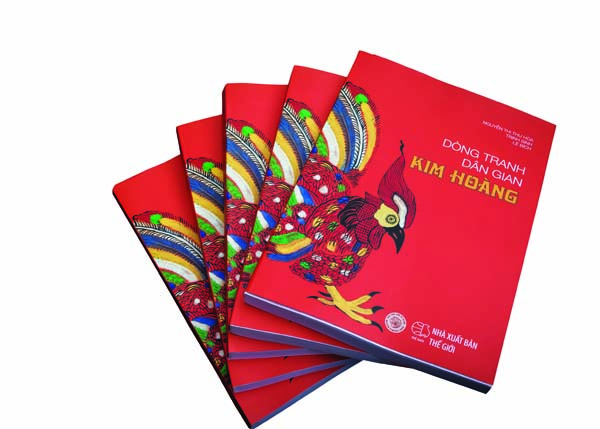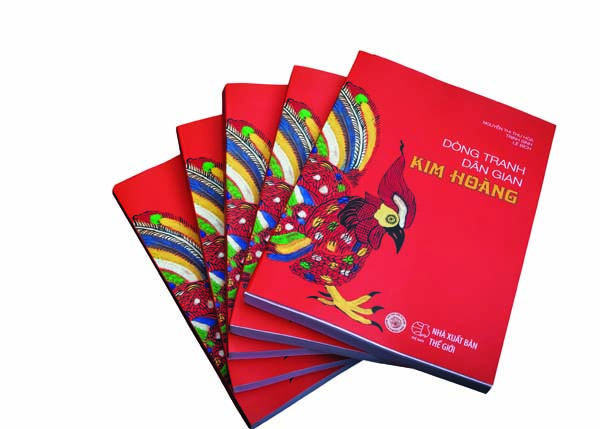(No.2, Vol.9,Apr-May 2019 Vietnam Heritage Magazine)







“We have the pleasure of presenting to you the new book “The Strain of Kim Hoang Folk Paintings.” This is one of the famous folk painting strains of our country, which has almost disappeared had there not been timely efforts to restore and promote it. In recent years, we have formed a project named “Restoration of Kim Hoang Folk Painting” which was an initiative of the director of the museum of Vietnamese ceramics and porcelain. The project attracted many artisans, collectors of Vietnamese folk paintings, artists, experts of culture and history of arts, and photographers.
We have made a step-by-step effort to approach the native land of this folk art strain, namely the Kim Hoang Village, Van Canh Commune, Hoai Duc District of Hanoi, talking to the few elders who saw firsthand the making and selling of the paintings. They told their stories, helped assess the authenticity of colors, painting techniques, and distribution channels of Kim Hoang paintings in country bazaars west of Hanoi etc. Finally we have succeeded in restoring the image of the trade village in its golden age.
The Vietnam Museum of Arts currently has a painting of two roosters, called the Divine Roosters, and the painting of swine from Kim Hoang. The village itself still preserves the big paintings “Duc Luu Quang” and “Phuc Man Duong” and some others. But Kim Hoang seems to have failed to keep those of its products once famously dubbed the “red paintings of Kim Hoang.”
Fortunately, many Kim Hoang paintings have been studied and publicized by a French scholar named Maurice Durand in a book titled “Vietnam Folk Painting”, published in 1960. In his work, he combined all folk painting strains of Vietnam into one, which includes Dong Ho, Hang Trong and Kim Hoang as well. We have managed to sieve out the Kim Hoang paintings from his book to preliminarily define the unique characteristics of Kim Hoang strain with the help of the village elders and many artists. To date, we have achieved many great results in this initial stage, enough to be compiled into this book “The Strain of Kim Hoang folk Paintings.”
To begin with, we would like to express our deepest gratitude to Mr. Maurice Durand, the artist and the scholar who has passed away, for the invaluable work “Vietnam Folk Painting” he left for us. Not only did he love Vietnam and carry some Vietnamese blood in his veins, but he also spent much time and effort to study Vietnamese paintings including those from Kim Hoang. The book he published is a true research work, which includes the most typical paintings that have the highest aesthetical value and contain many spiritual values of Vietnamese people.
To continue his life work, his son Mr. Marcus Durand in collaboration with French and Vietnamese experts, corrected the enormous amount of material he left, reprinted this famous work of his in France, translated and published it in Vietnam in 2017, beautifully in color. It was the work of the Durand father and son that gave us the initial idea and motivation to go deep into the study of Kim Hoang folk art, which remained known only in a very few places. Durand’s book was one of those places. With that we started looking for Kim Hoang paintings, defined the unique Kim Hoang characteristics, determined the colors that made up the “strain of Kim Hoang red paintings”, the lay-out, the Chinese characters in the annotation, etc. From there, we began working on restoring this precious strain of folk art. The French have loved Vietnamese folk art so much, how could the Vietnamese let the Kim Hoang strain of painting sink into oblivion without trying to revive it and give it the place it deserves in the artistic heritage of our country?
In Chapter 1, we describe in great details the village of Kim Hoang, the cradle of this strain of folk painting. This is a typical ancient Vietnamese village west of Hanoi, with its village temple built in 1704, adorned with typical carving of the Prosperity Age of the Le Dynasty. These carvings in the temple, close in theme to the paintings, hinted to us about the age of this strain of paintings, which may be a little earlier than the beginning of 18th century. The village still preserves many old customs as described in the village conventions, a written document that defines clans and fractions as structural elements, and the administrative body. Kim Hoang Village has six outstanding scholars named in the golden list. This fact is also uniquely reflected in the paintings by the annotation in Chinese characters.
The village is so interesting in many aspects. Therefore, this work is not only about the folk paintings, but it has also scholarly values pertaining to folk literature, ethnography, history and culture study etc.
In the second chapter, we go deep into the topic of restoring this strain of folk painting based on exploring ground zero, referencing various documents, analyzing and listing Kim Hoang paintings from M. Durand’s book, describing the method used to select those paintings from among the others in a document titled “Determining Kim Hoang paintings from M. Durand’s book, the 2017 color edition.” As a result, we sieved out 93 paintings from the book. These paintings have been authenticated by Kim Hoang village elders and discussed thoroughly by artists and art critics. We began studying in depth various aspects of the making of Kim Hoang paintings in hope of restoring the painting trade in the region. We tried to assess the cultural and artistic values of this strain of paintings, blowing oxygen to help make it viable and adaptable to the modern, contemporary life.
In the third and final chapter, we deal mostly with the technical and artistic aspects as well as the content of Kim Hoang paintings, hoping to find the unique features of this strain as compared to the famous Dong Ho and Hang Trong paintings. Kim Hoang paintings have their own peculiarities, uniquely serving a part of the society, namely the peasants in the west of Hanoi. It served well its market, especially during the period of New Year.
Our ambition is to continue the study and publishing of folk paintings, not only of this strain, but also of other strains such as Dong Ho, Hang Trong, Lang Sinh etc. We hope to have many more releases in the future on the invaluable tangible cultural heritage of our ancestors”.
From the speech at the launching of the book in February 2019 by three co-authors Nguyen Thi Thu Ho a, Director of Museum of Ceramics of Hanoi, Prof. Trinh Sinh and Photographer Le Bich.
Cover Price: VND 370.000
World Publishing House 6 Tran Hung Dao Str, Hanoi
Vietnam Heritage had an interview with Le Bich – the photographer of the Dong Tranh Dan Gian Kim Hoang ( The Strain of Kim Hoang Folk Painting)
How did you join this project? Please share your best impressions and memories doing this photo project.
A photographer specialized in traditional trade villages of Vietnam, I was invited by the manager of the Kim Hoang painting restoration project.
Being one of the first people who joined the project to take documentary pictures and videos, I understood the village and the villagers of Kim Hoang. I know how hard it is to restore the trade of the past that’s been long discontinued. Kim Hoang is an ancient village that has centuries-old traditions. Situated in a suburban area, it is being very quickly urbanized and the traditional values are at risk Nevertheless, many individuals and groups in the village are keen to preserve invaluable ancestral heritage. They contribute to protect the temples and pagodas, archive and translate conferment decrees, keep on conducting yearly village festivals, and teach village kids about the traditions etc. So when the project of restoring the Kim Hoang traditional painting trade was proposed it received enormous support of the locals.
I attended the Kim Hoang festival and rituals and learned about many beautiful local customs. The Kim Hoang village temple is quite beautiful, with unique lively carvings. The Dai Bi pagoda in the village is also very picturesque. Remarkably, the head monk here is so kind to shelter and educate many orphaned kids. The elders can tell you great stories about the old trade.
How do you grade the book, as the print is complete?
To me the book “The Strain of Kim Hoang Folk Painting” has the following values:
1. It reintroduces the strain of Kim Hoang folk painting, forgotten since the 40s.
2. It lets generations of Kim Hoang villagers once again understand and be proud of their village and ancestral legacy (the book tells also about the history of the village and the region.)
3. It contains valuable, real materials for those in the field of cultural heritage restoration in general and folk painting restoration in particular.
4. It is a rich source of reference material for those who want to study Vietnamese folk painting, most notably the photographic material, including 353 photographs about the village, the painting trade, and the people who conducted the project and made it a success.
Thank you.

